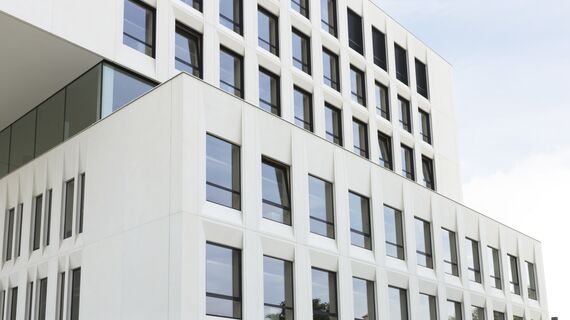- Bontinck
't Rabot
The Belgian city of Gent’s Rabot district, located alongside the 19th-century ring around the city, is undergoing a major facelift. The district authorities’ Bruggen naar Rabot (‘Bridges to Rabot’) master plan is intended to restore the links to the city centre. Each of the old industrial weaving mills along the ring road – which formed the basis of the district’s glory in the 19th century – is to be assigned a specific new function, such as housing, offices and design stores. The site of the former marshalling yard on the opposite side of the road now proudly accommodates Gent’s new courthouse and a youth centre. G+D Bontinck designed a new office block, the ‘Rabot offices’ in the midst of these 19thcentury weaving mills. The Rabot district, with its location alongside the city ring road and its excellent accessibility by public transport, was the ideal location for the new office block. Moreover, the district is within walking distance of the historical city centre. The building’s closed end façade faces the ring road, a design inspired by the closed form and stone walls of the ‘Rabot’, the 15th-century sluice with two small towers. The front and rear façades are constructed from prefabricated concrete wall panels which have a rough pebbledash finish to provide protection from dirt and noise hindrance, and prevent people looking into the building. The high-tech open side façade – in complete contrast to the end façades – is comprised of a glass curtain wall, sun blinds, and a partially-corbelled gallery.
Consequently, away from the closed wall facing the street, the office block reveals itself as an open and transparent building. The glass side façades offer the lower floors of offices a view of the semi-public inner garden; the top floor of offices have a view of Gent’s historical city centre and its three towers. The gallery guides visitors to the central reception area and the halls serving the offices, as well as to the underground car park and the inner garden at the back. The office building is of a simple design; the two end façades sandwich the lateral façades, with their slatted screens, which front four storeys of offices. An open lift shaft and a stairwell glazed over the entire height are located at the centre of the building, as a result of which the building can be divided into two autonomous office sections. The orientation of the closed end façades and open lateral side façades is extremely favourable to the building’s office function: the glass façades face northeast and southwest, thereby allowing the low sun in the morning, afternoon and winter to enter the building, whilst the slatted wall and closed end façades block the high sun.
ALUMINIUM
“Two factors played a role in the choice of the aluminium window profiles for the façades” explains Bert Dekeyser, G+ D Bontinck’s Project Manager for the office block, “namely architectural and engineering factors.” The architects’ design envisaged a high-tech façade comprised of curtain walls and sun blinds. Aluminium was the perfect material for this design. The end user was not known at the time of the design, and consequently the client required a building that offered the greatest possible flexibility and user-friendliness. The building was designed so that it could be divided into two completely separate office sections, each of which can be accessed from the hall. The selection of materials for the building took explicit account of the client’s durability and maintenance requirements; and once again, aluminium profiles met these requirements in full. A number of modifications were made to the design during the construction work in anticipation of more stringent energy standards in the future. The insulation value of the double glazing was increased, and the constructors opted for the slender profiles of the CW 50 system and its excellent thermal insulation value. The maintenance balconies and slat screens were mounted on the CW 50 system. In combination, the wide gap between the slat screens and the glass façade, the angle of the slats, the minimal dimensions of the profiles and the distances of the horizontal glazing beads all result in an extremely transparent façade offering high energy efficiency.
Korišćeni sistemi
Involved stakeholders
Arhitekta
- Bontinck
proizvođač
- Hermans
Fotograf
- Louis Jongeneelen
Ostali stejkholderi
- VKW Synergia (Investitori)
- Franki (General contractors)










